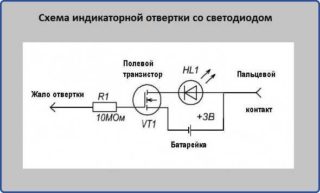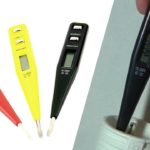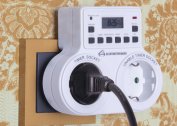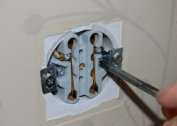When servicing electric networks and their emergency repair, it is difficult to do without a special tool designed to detect potential on the supply wires. One of such devices is an electric indicator, which has several versions. Regardless of the model of a specific fixture, all of these samples have a classic design and work on a similar principle. The order of their use depends on the internal device and the method of displaying information on the indicator.
The principle of operation of the display device
The simplest phase indicator in the wiring is a small-sized design made in the form of a pointer or a screwdriver. It includes the following required parts and assemblies:
- working metal probe, like screwdrivers;
- a neon bulb having two flat contacts;
- resistor with a resistance of 1 megohm;
- conductive contact plate with clamping spring.
Such an indicator is used only to identify the phase, the presence of voltage, as a potential difference, it cannot be determined with its help. The zero core is usually found by exclusion. The general principle of operation of indicator devices consists in the formation of an additional chain branch, through which a current safe for the operator flows.
In various types of screwdrivers, the selection of energy for indication is made in its own way, not like other methods.
 In simple devices with a built-in neon lamp, a microscopic current flows through the internal chain, causing a weak indicator glow. This effect is possible only when the operator touches the metallized plate of the screwdriver. Contact with the human body is necessary to divert the current safe for it to earth (creating a closed leakage circuit to zero). Due to the weak glow of the neon indicator, it is very difficult to use it in sunny weather or in bright light.
In simple devices with a built-in neon lamp, a microscopic current flows through the internal chain, causing a weak indicator glow. This effect is possible only when the operator touches the metallized plate of the screwdriver. Contact with the human body is necessary to divert the current safe for it to earth (creating a closed leakage circuit to zero). Due to the weak glow of the neon indicator, it is very difficult to use it in sunny weather or in bright light.
Types of indicator screwdrivers and their device
In addition to the classic version (neon screwdriver), the industry produces many other indicator devices. Among them, the following well-known models stand out:
- indicators with a liquid crystal scale;
- LED devices with built-in battery;
- contactless electronic voltage testers - they are called "smart" screwdrivers.
- With liquid crystal display
- LED screwdriver
- Contactless detector
Products with liquid crystal indicators, as well as screwdrivers with LEDs, are characterized by increased functionality. They can not only detect the presence of a phase, but also evaluate the magnitude of the voltage acting in the circuit. With their help, it is possible to determine the zero contact, information about which is represented as the absence of scale divisions. With an intermediate value of the voltage acting in the circuit (110 volts, for example), the indicator displays a half deviation from zero.
Electronic testers have a more complex device and allow you to check the circuit in a non-contact way due to electromagnetic interference. They can also be used for test detection of hidden wiring and the presence of voltage in the cable laid in the wall.
To work with existing power circuits, you need to know how to use voltage screwdrivers with an LED and a battery to determine the desired wire.But first, it is important to understand the design of these devices, as well as the principle of their action.
LED screwdriver working principle
The basis of the indicator circuit design is based on the following main elements:
- work sting;
- field effect transistor on which the key stage is assembled;
- regular LED and three-volt battery;
- top contact.
A 3 Volt battery built into the instrument is needed to power the electronic key circuit.
When the meter touches the exposed part of the wiring or contact with the phase voltage, the tested potential opens the field-effect transistor, through which direct current begins to flow. Thanks to this, the built-in LED lights up - indicates the presence of potential. When checking the zero core of the electrical wiring, this does not happen, since the key remains in the closed state - the LED does not light.
How to use the LED indicator screwdriver

To check the phase and zero with indicator screwdrivers with a built-in LED, you will need to examine their design. At the bottom of the electronic pointer there is a working probe, which when testing touch bare contacts. A contact plate is located on its upper cut, when pressed, the battery power circuit is closed - it performs the function of a switch.
The housing has a hole with an integrated LED in it, according to which it is possible to find out about the presence or absence of voltage. To do this, do the following operations:
- The screwdriver is taken in the right hand so that the thumb is located directly above the contact plate (switch).
- It is necessary to touch a sting to the tested terminal socket, for example.
- At the same time, press the upper plate with your finger and visually check the status of the LED.
If it lights up after carrying out all the manipulations, there is voltage on the contact or core under test. Otherwise, it is absent at this point. The same effect will be observed if zero power supply wiring is controlled.
The main types of checks
To determine the presence of a phase in the circuit under test, it is necessary to follow generally accepted rules for handling an indicator screwdriver and similar devices. The order of work is determined by the model of the tool used and the features of its design. Depending on this, the test can be contact or non-contact, as well as designed to detect a break or search for the route of the wiring. In the first case, it is necessary to touch the tip of the screwdriver to the contact of the bulb holder, for example, and make sure there is no voltage on it.
In the second approach, to check for the presence of a phase, it is enough to bring the control part of the screwdriver to the circuit under test (without touching it). In the same way, they act if you want to determine the route of laying hidden in the wall of the wiring, using electronic voltage testers for these purposes. In addition to these simple operations, indicator devices are used to search for a wire break, which, when hidden, is recessed in the thickness of the walls.
Cliff search
There are many electronic devices by which it is possible to find a cliff hidden from the eyes of the user under a layer of plaster or concrete. Some of them work on the principle of a metal detector that can detect metal objects by reflection from them of a signal generated by the device. It is possible to find damage in the wiring due to the fact that reflection does not occur in the breakage zone and the response signal weakens.
The cost of such devices is quite high.To find out where the cliff is located, it is better to use indicator devices that work on other principles.
To search for a cliff of conductors at home, devices that are considered the best in their class in terms of price and quality are suitable. We are talking about a domestic product called the Woodpecker and the E-121 signaling device. With their help, you can search for the exact route of the wiring in the wall, as well as easily detect a break in its veins. The depth of penetration of the control signal into the thickness of the walls is not more than 7 cm. This is quite enough to detect a dangling wire going to a room lamp, for example, even under a thick drywall plate.
The principle of operation of these devices is based on the registration of residual electromagnetic energies that retain their field structure even in a dangling conductor. The only condition for the efficiency of such devices is that alternating voltage must act at the ends of the controlled circuits.
If there is an indicator screwdriver with an LED in the homemaster’s tool kit, the user will be able to solve many issues related to the internal power supply maintenance on their own. This approach is the only correct one, since it allows you to independently deal with existing problems, as well as save significantly by refusing to call an electrician.









